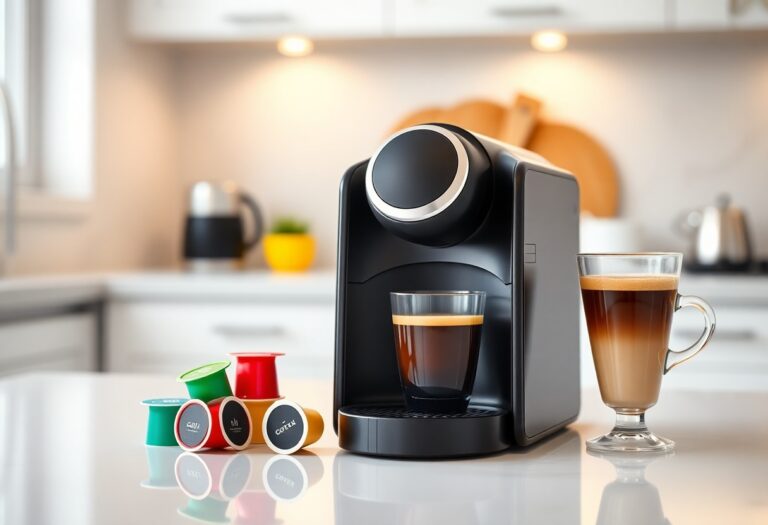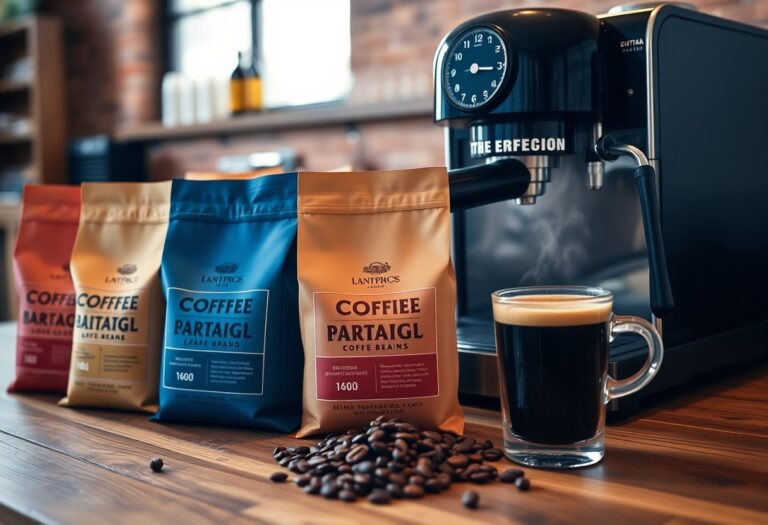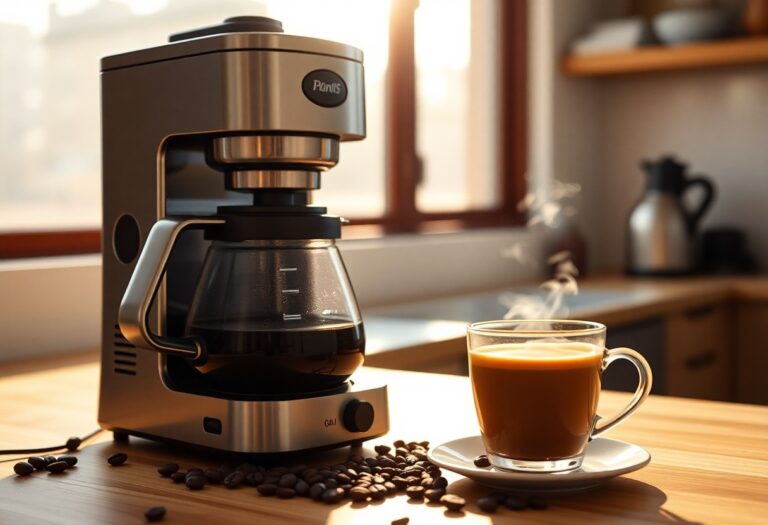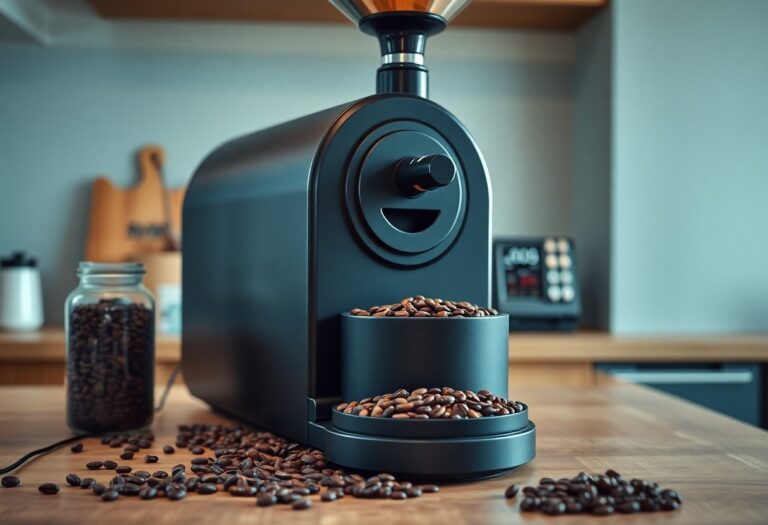What is a French Press Coffee Machine: Complete Explanation
French press coffee machines, also known as cafetières or coffee plungers, are beloved manual brewing devices that have stood the test of time. They represent a popular manual brewing method in the world of coffee.
In this article, we delve into the complete explanation of the French press coffee machine, uncovering its intricate components and the fascinating working mechanism behind its brews. We will also shed light on its unique advantages and provide a comprehensive guide on how to use a French press coffee machine.
Understanding the Components and Working Mechanism of a French Press Coffee Machine
The French press components are elegantly simple yet essential for producing rich coffee. The device primarily consists of three parts:
- Cylindrical beaker: Usually made from glass, stainless steel, or plastic, this container holds the coffee grounds and water during brewing. Its shape allows for even immersion of the grounds.
- Lid: Fits snugly on top of the beaker; equipped with a hole through which the plunger rod passes.
- Plunger with mesh filter: This is the core of the coffee plunger design. The plunger consists of a rod attached to a circular metal or nylon mesh filter. The mesh is fine enough to separate coffee grounds from liquid but coarse enough to allow natural oils and flavors to pass through.
The cafetière parts work together in a straightforward manual brewing technique based on immersion rather than filtration.
Step-by-Step Coffee Steeping Process
- Add coarsely ground coffee: Use a coarse grind to prevent clogging and over-extraction. Fine grounds can slip through the mesh filter or make pressing difficult.
- Pour hot water at ideal temperature (93–96 °C): Water that is too hot scorches coffee; too cool results in weak flavor extraction.
- Steep for about 4 minutes: During this time, coffee grounds fully immerse in water, releasing oils, aromas, and soluble compounds evenly.
- Press the plunger down slowly: This separates the brewed coffee from the grounds by pushing them to the bottom while leaving liquid coffee on top.
This process exemplifies an immersion brewing method, where water and coffee grounds stay in contact throughout brewing time.
Immersion vs. Drip Brewing
Unlike drip machines that pass hot water through coffee grounds via gravity, French press brewing fully immerses grounds in water, allowing more thorough extraction of flavors and oils. This creates a fuller-bodied cup with richer mouthfeel.
The use of coarse grind prevents:
- Clogging of the mesh filter
- Excessive bitterness caused by over-extraction if grounds stay submerged too long or get pulverized
The balance between grind size, water temperature, and steeping time forms the foundation of mastering this manual coffee brewing technique. Understanding each component’s role helps you control variables for consistent results every time you brew with a French press.
However, if you also own other types of coffee machines like a Cuisinart, Keurig, or Krups, it’s essential to understand how to maintain them properly as well. For instance, you might want to learn how to make espresso without an espresso machine or follow our beginner’s guide on making coffee with a machine.
Exploring the Flavorful World of French Press Coffee
French press coffee offers a unique experience due to its distinctive characteristics:
1. Richness and Fullness of Flavor
The French press brewing method extracts essential oils and flavors from the coffee grounds, resulting in a full-bodied and rich cup of coffee. Unlike drip coffee makers that use paper filters trapping some oils, the French press allows these natural oils to pass through, enhancing the taste profile.
2. Metal Mesh Filter’s Role in Flavor Extraction
The metal mesh filter in a French press plays a crucial role in flavor extraction. It permits the passage of natural oils and fine particles that contribute to the coffee’s robust flavor profile. This is in contrast to paper filters that absorb some of these oils, leading to a less intense taste experience.
3. Impact on Taste Profile and Mouthfeel
The immersion brewing process of a French press ensures that all coffee grounds are fully saturated with water, promoting optimal extraction of flavors. This results in a bolder taste profile with nuanced flavors and a smooth mouthfeel. The absence of paper filters allows for a richer and more textured coffee experience.
French press coffee stands out for its ability to deliver a flavorful and aromatic brew that captures the essence of the coffee beans used. The combination of full-bodied richness, enhanced natural oils, and unique mouthfeel sets French press coffee apart from other brewing methods.
For those who also enjoy using other types of coffee machines, maintaining them properly can significantly enhance their performance. If you own a Bunn coffee machine, you might find this guide on how to clean a Bunn coffee machine useful. Similarly, if you’re interested in personal maintenance for your coffee machine, this personal maintenance guide could be helpful.
Additionally, understanding how to use a coffee machine can make your brewing experience smoother. For those who prefer filter coffee machines, here are some brewing instructions that may assist you.
Advantages and Considerations When Using a French Press Coffee Machine
The simplicity of use makes the French press a favorite among manual brewing methods. You don’t need electricity or complicated machinery—just coarsely ground coffee, hot water, and a few minutes of your time. This straightforward process is especially handy when you’re traveling, camping, or simply want to enjoy great coffee without relying on power outlets.
Portability and Convenience
- No electricity required: Ideal for outdoor adventures or places without reliable power.
- Compact design: Easy to pack in luggage or backpacks.
- Minimal accessories: No paper filters needed, which means fewer supplies to carry and less waste.
Eco-Friendly Coffee Brewing
Using a French press reduces environmental impact significantly:
- Reusable mesh filter: Unlike paper filters that generate waste per use, the stainless steel or nylon mesh can be cleaned and reused indefinitely.
- Less packaging waste: No single-use pods or disposable components involved.
- Energy efficient: Manual operation means zero electricity consumption during brewing.
These factors align well with sustainable living practices, making the French press an appealing choice for eco-conscious coffee lovers.
Versatility Beyond Coffee
The French press isn’t limited to just brewing coffee. It offers flexibility for other beverages through its immersion method:
- Loose-leaf tea: Steep tea leaves directly in the press, then separate them easily using the plunger.
- Cold brew coffee: Extend steeping time (often 12-24 hours) at room temperature or in the fridge for smooth, low-acid cold brew without specialized equipment.
This multi-functionality adds value to owning a French press, as it can serve multiple purposes in your daily beverage routine.
While the French press has its unique advantages, it’s worth noting that there are other coffee machines available that also offer great functionality. For instance, if you’re looking for something more automated, you might consider exploring how to use a Keurig coffee machine or how to operate a Ninja coffee machine. Alternatively, if you prefer espresso, you could check out this brewing guide on making coffee with an espresso machine.
The combination of portability, environmental benefits, and versatility highlights why so many people turn to the French press for their manual brewing needs. It’s a simple yet effective tool that fits various lifestyles while delivering quality results.
Choosing the Right French Press Coffee Machine for You
Selecting a French press coffee machine involves balancing material, durability, and design to match your brewing preferences and lifestyle.
Material Differences
- Glass French Press: Offers clear visibility of the brewing process, letting you monitor coffee strength and color. Glass models tend to have an elegant, classic look but are more fragile and prone to breakage. Ideal if you brew mostly at home and want aesthetic appeal.
- Stainless Steel French Press: Known for superior durability and resistance to chipping or cracking. Stainless steel presses often feature a sleek, modern design and can withstand rougher handling. They retain heat better than glass but don’t allow visual monitoring during brewing.
- Insulated Coffee Press: Typically made from stainless steel with double-wall insulation. These models keep coffee hot for longer periods without reheating, perfect if you sip slowly or need to carry your brew on the go. Some insulated presses prioritize functionality over transparency.
Design Considerations
- Size matters depending on how many cups of coffee you usually prepare—ranging from single-serve to large-capacity models.
- Handle comfort and grip stability play a role when pouring hot coffee.
- Filter quality influences ease of pressing and prevents grounds in your cup; look for durable mesh screens that are easy to clean.
- Lid fit affects heat retention during steeping.
Choosing between these options depends on whether you prioritize durability, heat retention, or the ability to see the brewing process. Each material offers unique benefits that cater to different brewing habits and environments.
Brewing Tips, Maintenance Guide, and Beyond with Your French Press Coffee Machine
When using a French press coffee machine, mastering the brewing process can elevate your coffee experience. Here are essential tips and maintenance guidelines to ensure optimal results and longevity of your device:
Steeping Time and Water Temperature
- Steeping Time: The recommended steeping time for French press coffee is around 4 minutes. This duration allows the coffee grounds to release their flavors without over-extracting, which could result in bitterness.
- Water Temperature: To achieve the best extraction, use water at temperatures between 195-205°F (90-96°C). Boiling water can scald the coffee, while water that’s too cold may not extract enough flavor.
Serving Freshness and Flavor Preservation
- Immediate Serving: After pressing down the plunger, serve the brewed coffee immediately to preserve its optimal flavor profile. Leaving coffee in the press can lead to continued extraction and bitterness.
Maintenance Tips
Proper maintenance is key to ensuring your French press remains in top condition:
- Disassembly and Cleaning: Regularly disassemble your French press for thorough cleaning. Scrub all components with warm, soapy water to remove coffee residues that can impact taste.
- Mesh Filter Care: Pay special attention to the mesh filter. Rinse it after each use to prevent clogging and maintain its effectiveness in filtering out grounds.
- Lifespan Extension: To extend the lifespan of your French press, avoid using abrasive cleaners that could damage the glass or metal components. Handle with care when assembling and disassembling.
For those who also own other types of coffee machines like Keurig, Mr. Coffee, or K-Cup machines, similar maintenance principles apply. Each type of machine has its own unique cleaning requirements which are crucial for extending its lifespan and ensuring optimal performance. For instance, if you’re wondering how much vinegar to clean a coffee machine, it’s important to follow proper ratios for effective cleaning.
By following these brewing tips and maintenance guidelines, you can enjoy consistently delicious coffee from your French press while prolonging its longevity for many more brews to come.
Beyond Coffee: Exploring Other Uses for a French Press Coffee Machine
French press coffee machines are not limited to brewing your morning cup of joe. They can also be versatile tools for exploring other delicious beverages:
1. Brewing Loose-Leaf Teas
The French press’s steeping method is perfect for extracting the flavors of loose-leaf teas. Simply add your favorite tea leaves to the beaker, pour hot water at the ideal temperature, steep for the recommended time, and press down the plunger to enjoy a flavorful cup of tea.
2. Making Cold Brew Coffee
Transform your French press into a cold brew maker by mixing coarsely ground coffee with cold water and letting it steep in the refrigerator for 12-24 hours. This extended steeping process results in a smooth, less acidic cold brew coffee that you can enjoy over ice.
Experimenting with different teas and coffee varieties in your French press can open up a world of flavors beyond traditional brewing methods. Whether you prefer a relaxing cup of herbal tea or a refreshing glass of cold brew, your French press can cater to a variety of tastes and preferences.
However, if you’re looking for more advanced techniques or want to explore other types of coffee machines like Keurig, or Cuisinart, there are plenty of resources available. For instance, you might want to learn about manual brewing methods which can provide even more flexibility in your coffee-making endeavors.
It’s also important to remember that maintaining your coffee machine is crucial for optimal performance. Using [natural cleaning methods](https://www.coffeemakerexpert.com/how-to-clean-a-coffee-machine-with-vinegar-natural-cleaning-method) such as cleaning with vinegar can help keep your machine in top shape. Additionally, understanding how to descale a coffee machine is essential for prolonging its lifespan and ensuring the best possible taste from your brews.
Conclusion
The manual immersion brewing summary highlights the simplicity and richness that define the French press coffee experience. This method extracts deep flavors and natural oils, delivering a full-bodied cup that electric machines often miss. Understanding what is a French Press Coffee Machine: Complete Explanation equips you to appreciate its unique charm.
- No need for electricity or paper filters
- Easy to use and maintain
- Produces bold, aromatic coffee
Embrace the benefits of French press coffee machine brewing by giving it a try. Your palate will thank you for exploring this timeless way to enjoy coffee.







